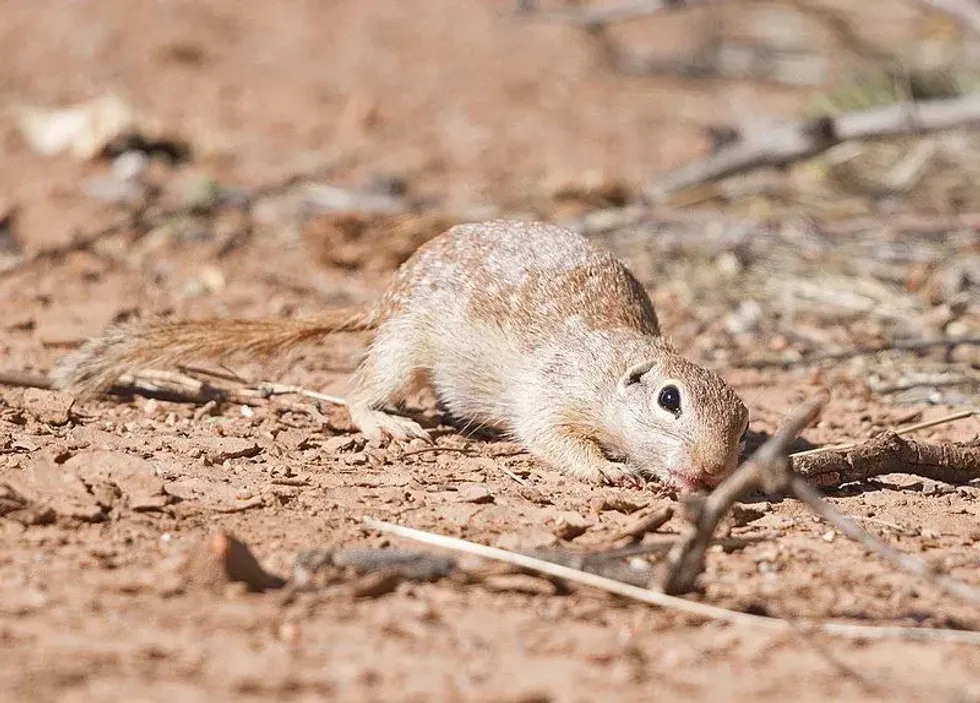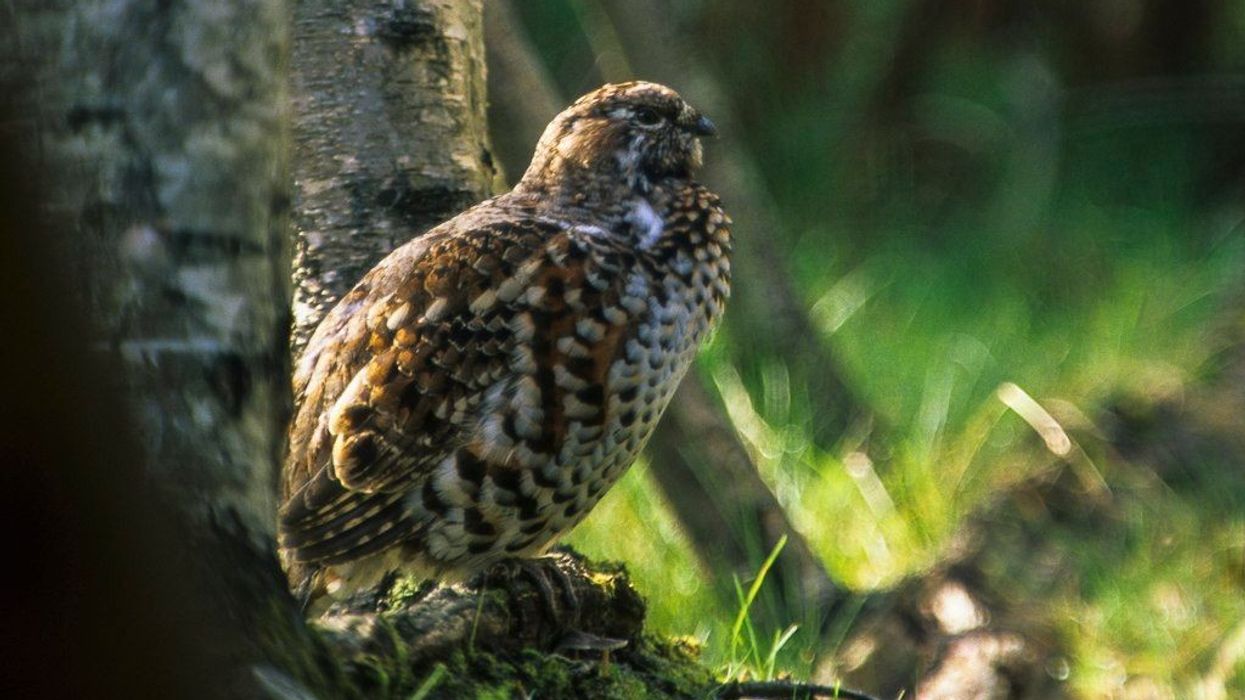Spotted ground squirrels (Spermophilus spilosoma) are a species of ground squirrels and are often found in North America and Central Mexico. These squirrels are often recognizable thanks to their white linear-dorsal spots and their white underparts. They are ground dwellers and dig burrows to live in or they might use abandoned burrows of prairie dogs.
Spotted ground squirrels hibernate in the winter, but this is not obligatory as the ones inhabiting the southern parts of their range might not hibernate compared to the ones living in the north or the western regions.
Juvenile spotted ground squirrels have a darker coat of fur compared to adults and the fur color depends on the surrounding as the squirrels living in areas rich with soil tend to have a darker shade than the ones living in grassland populations.
If you liked these true facts about spotted ground squirrels, then you'll surely like these facts about the chicken and the flying squirrel too!
Spotted Ground Squirrel Interesting Facts
What type of animal is a spotted ground squirrel?
Spotted ground squirrels (Spermophilus spilosoma) are a species of ground squirrels and are the smallest squirrels found in the Northern Hemisphere. These small ground dwellers are burrow diggers and are often seen as a pest in their habitat distribution range as they damage vegetation with their burrowing which is a seasonal activity.
Also, it is an outcome of their breeding habits as they produce young who destroy vegetation by burrowing into the ground and changing the soil structure.
What class of animal does a spotted ground squirrel belong to?
Spotted ground squirrels belong to the mammal class of animals. The presence of mammary glands to feed their young ones, with three ear bones, fur or hair, and the neocortex (region of the brain) is what qualifies these squirrels as mammals.
How many spotted ground squirrels are there in the world?
The population of spotted ground squirrels (Xerospermophilus spilosoma) is tough to state due to a lack of data as this squirrel species is abundantly found in their habitat range and due to the resource richness of their habitats, they have plenty of food sources like flowers and seeds, and green plant parts which help in their large distribution in their native range.
Another factor that helps this species of squirrel to occur in a large number are their hibernation habits which leads to a natural abundance.
Where does a spotted ground squirrel live?
Spotted ground squirrels (Spermophilus spilosoma) usually inhabit areas that have deep sandy soils with sparse vegetation. In the northeastern parts of the United States, they are found in the sand-hills and in the southeastern part of the Arkansas River.
This squirrel species is also found throughout the Mexican and central and western United States, with the habitat distribution from south-central South Dakota to Nebraska. They are also found in the eastern range of Colorado, western Kansas, Texas, Arizona, New Mexico, and in the southern part of Utah.
A large population is also found in parts of south and central Mexico.
What is a spotted ground squirrel's habitat?
Since this species of ground squirrels are burrow diggers, a majority of the population prefers to live in deep sand soils with sparse vegetation.
In some regions, this spotted ground squirrel species also inhabits sand-hills and dunes and will go through hibernation in the abandoned burrows of prairie dogs. The burrow of a spotted ground squirrel is usually found in short grass or along river banks.
This squirrel species will create their burrow in sparse soil, hence their burrows are usually found in arid or dry landscape regions that have sparse soil with lots of green plants which makes a large part of their diet.
Who do spotted ground squirrels live with?
Spotted ground squirrels (Spermophilus spilosoma) are a colonial species of squirrels and prefer to live in close proximity to each other in a small family. These groups consist of males, females, and the young.
This colonial behavior in their population is mostly used as a means to avoid predators and for easy foraging of food sources like seeds, green grass shoots, and plants.
Spotted ground squirrels spend most of their time in hibernation which begins in late July and ends in April and May of the next year. The seasonal activity is estimated to be 115-135 days for males and 95-125 days for females.
How long does a spotted ground squirrel live?
Spotted ground squirrels are animals with a short lifespan and in their natural habitat, they survive up to two to three years. This lifespan is a rather short one given they have to take part in activities like the breeding season and hibernation.
Even this two to three year lifespan is not guaranteed as they become prey to their predators.
How do they reproduce?
Not much is known about the mating activity of spotted ground squirrels. It is however known that these small ground-dwelling animals have an annual breeding season which usually lasts between the months of April and May, and in some cases, ends in mid to late July.
During the mating season, males of spotted ground squirrels display a frenzy type activity and enter and exit their burrows sporadically, which is a sort of a courting behavior.
What is their conservation status?
Spotted ground squirrels (Spermophilus spilosoma) are currently listed as a species of Least Concern on the IUCN Red List due to their large population as they have a broad range of habitats and are not under threat as they spend most of their time in their burrows after stocking up on seeds and plants.
Due to these factors playing a large part in their population, it is tough to see spotted ground squirrels becoming close to being threatened.
Spotted Ground Squirrel Fun Facts
What do spotted ground squirrels look like?
Spotted ground squirrels have white non-linear dorsal spots, with white underparts. The tail length is 2.1-3.5 in (5.3-8.8 cm), hind-foot is 1.1-1.2 in (2.8-3 cm) in length with the skull adding another 1.3-1.6 in (3.3-4 cm). All these take these squirrels to a total body length of 7.28 to 10 in (18.4-25.4 cm).
The fur color of the spotted ground squirrel can be either gray, brown, or black depending on the environment surrounding the areas they live in.
How cute are they?
As we all know, squirrels are one of the cutest animals in the world and these ground squirrels are no exception! These animals are absolutely cute to look at as they break nuts and seeds with their tiny paws.
How do they communicate?
The spotted ground squirrel (Spermophilus spilosoma) communicates with each other using various visual, tactile, acoustic, and chemically induced methods.
This squirrel species uses at least seven different alert postures that are used to warn other members of the family or group of the presence of predators in the area or to claim territory against competing males during the breeding seasons.
How big is a spotted ground squirrel?
The spotted ground squirrel (Spermophilus spilosoma) species is the smallest squirrel found in the Northern Hemisphere and only grows to a total length of 10 in (25.4 cm).
How fast can a spotted ground squirrel run?
Due to a lack of data, the speed at which these squirrels run cannot be stated.
How much does a spotted ground squirrel weigh?
These small mammals do not weigh much and an adult ground squirrel weighs between 3.8-4.2 oz (110-120 g).
What are the male and female names of the species?
A male spotted ground squirrel is called a buck and a female spotted ground squirrel is called a doe.
What would you call a baby spotted ground squirrel?
A baby spotted ground squirrel can either be called a pup, kitten, or a kit.
The pups stop depending on their mothers for nourishment following their venture out of the burrow after two to three weeks.
What do they eat?
Spotted ground squirrels (Spermophilus spilosoma) are omnivorous in nature and are often seen eating seeds and plants as their preferred food source. They also eat grasshoppers, worms, insect larvae, flies and lizards.
Are they dangerous?
No. These are docile creatures and will not harm humans or other animals.
Would they make a good pet?
The spotted ground squirrel (Spermophilus spilosoma) species has not been domesticated as these creatures are tough to take care of and are not recommended to be kept as pets.
Did you know...
These critters sometimes can get inside your house through tunnels and burrows that they make under your lawns or gardens.
These squirrel family members might look cute but in truth, they are one of the few species that practice cannibalism. They eat their own kind and there have been many witnesses of them cannibalizing their own.
The synonym of their scientific name Xerospermophilus spilosoma is Spermophilus spilosoma.
The speckled ground squirrel (Spermophilus suslicus) is a close relative of the spotted ground squirrel and is found in eastern Europe.
What is the litter size of spotted ground squirrel?
In the breeding season, once the males and females have mated, females will go through a gestation period of 24 days after which they will give birth to four to 12 babies in their burrows. These young babies are usually taken care of by the females as they will protect them from predators, feed them, and wean them.
Males rarely play a part in weaning or caring for the young.
Are spotted ground squirrels bad for your yard?
Yes! Spotted ground squirrels are bad for your backyard as even one ground squirrel is enough to ruin your landscape, kill your trees, and shrubs by burrowing as they prefer to live in short grass and sandy soils.
These squirrels will eat up whole seedlings, vegetables, fruits, and berries as all of these are an important part of their diet.
Spotted ground squirrels will also cause structural damage as they dig under your house and make cracks in the foundation that can be tough to fix.
Here at Kidadl, we have carefully created lots of interesting family-friendly animal facts for everyone to discover! For more relatable content, check out these Amazon river dolphin facts and Island fox facts for kids.
You can even occupy yourself at home by coloring in one of our free printable Spotted ground squirrel coloring pages.










